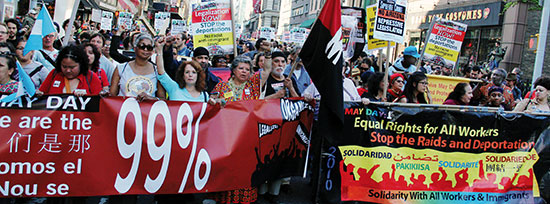New York’s May Day: A new level of struggle
By
John Catalinotto
New York
Published May 9, 2012 9:38 PM
|
May Day march, NYC.
WW photo: Brenda Ryan
|
Strong participation by Occupy Wall Street and unity with sectors of organized labor and the immigrant rights movement added a new dimension to May Day in New York in 2012.
According to organizers, some 50,000 people stretched along Broadway from Union Square to Worth Street in their march to the financial district. The 99% had taken to the streets in force.
The mass march along Broadway was the central action of a day of events starting early in the morning at what was billed as the “99 Pickets” campaign. This included a protest at the central Post Office against plans to lay off 200,000 workers and curtail services.
The day included rallies, classes and discussions at Bryant Park, Madison Park and what has become a regular Union Square gathering of the May 1 Coalition for Worker and Immigrant Rights, this year from noon to 4 p.m. OWS held some actions that involved civil disobedience. Police were out in force wherever OWS contingents marched, and dozens of demonstrators were arrested during the day.
A series of discussions carried out over two months by the “four-by-four” committee resulted in an agreement among organizers from the OWS, labor unions and the May 1 Coalition for a unified rally at Union Square Park from 4:00 p.m. to 5:30 p.m. and the march along Broadway.
Teresa Gutierrez of the May 1 Coalition told Workers World that the New York City Central Labor Council endorsed the May Day activities and that a number of important unions in the city actively mobilized.
Those unions with contingents carrying signs on Broadway included the Communications Workers; the Transit Workers Union Local 100; Teamsters Local 808; Local 768 of District Council 37 of the American Federation of State, County and Municipal Employees Union; the Professional Staff Congress of the City University; and Service Employees Local 1199.
In a talk in New York on May 5, Gutierrez noted, “In 2006, it was a thoroughly progressive step forward for the overall class struggle that an immigrant resurgence revived May Day in the United States.”
This year, the May 1 Coalition was there in Union Square and on Broadway. They included the Filipino-based BAYAN-USA and the National Alliance for Filipino Concerns, other groups from Asia and Africa, and from Mexico, Central America and the Caribbean, and the rest of Latin America, like the Dominican Women’s Development Center, the Honduran Resistance and others. May 1 is demanding full amnesty and legalization for all immigrants and is fighting for the rights of all workers.
Gutierrez underlined that “the Occupied Wall Street movement has taken May Day to a whole other level. When the OWS movement chose May Day to send a message to the 1% that despite repression, despite the city’s success in shutting down Zuccotti Park, this movement had not gone away, it was a tremendous flex of muscle. OWS participation in May Day,” she said, “was a step forward in the struggle to defend not only immigrant rights but all workers’ rights.”
People came to New York from the surrounding region for May Day. Workers World spoke with Viveca Andrews, secretary, and Eugene Powell, president, of the Central Labor Council of Stroudsburg, Pa., who had come in for May Day. The two said they were trying to put together a workers’ march for Stroudsburg, a small central city in the Pocono Mountains, to wake up the workers and bring the unions together in what is not a progressive region.
At the Workers World literature table, David Karp and Martez Smith, students at Ohio State University in Columbus, spoke of their efforts to confront hate crimes on campus, like graffiti directed against Black students or Muslim students. This Big 10 college is known for its sports teams, not for a politically active student body, but the two told how they wanted to organize a “teach-in” and a group that they called “Stand Your Ground,” turning the rightist slogan on its head.
Activists distributing leaflets and placards throughout the crowd in Union Square remarked on how many of the people they met told them they were on their first demonstration ever, pulled in by the growing mood of struggle over the past seven months. “OWS was in fact decisive,” Gutierrez said, “in pulling out the huge number of 50,000 people here in New York City.”
Gutierrez was confident that the movement that showed itself on May Day “will rise to the task. The deepening economic crisis, the growing racism and repression is fueling a train that cannot stop.”
Articles copyright 1995-2012 Workers World.
Verbatim copying and distribution of this entire article is permitted in any medium without royalty provided this notice is preserved.
Workers World, 55 W. 17 St., NY, NY 10011
Email:
[email protected]
Subscribe
[email protected]
Support independent news
DONATE


